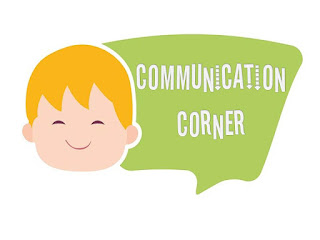Yes/no can be expressed in many ways:
- verbally
- head nod (yes) or turn (no)
- sign language
- gross motor gesture (clap)
- fine motor gesture (blink)
- pictures/text
- voice output device
 |
| Portable Yes/No Picture Symbols Karyn Smith Tri-Village High School, Tri-Village |
 |
| Yes/No Desk Visual Angie Kleinhans Stebbins High School, Mad River |
First Step "Do you want...?"
Determine the best way for your student to express yes/no. If possible, go with a universal mode everyone can understand such as verbal, head nod, pictures or voice output. Once you have identified a mode of expression, you will want to assess the student's ability to understand a simple yes/no question. Start with the motivating and meaningful question "do you want....?" Being able to respond to the question, "do you want...?" is a critical skill for students with limited communication. It will allow you to give options and better determine the wants and needs of the student.
 |
| Yes/No Voice Output Susan Trissell Westwood Elementary, Dayton |
Consider how you can assess and teach a clear and accurate response to this question using these easy steps:
- Gather items that are highly motivating and neutral or nonpreferred and place them in a bin.
- Present the items, one at a time. Ask the student "Do you want this?" Hopefully you will be able to determine if they want the item based on behavior. If it is not obvious, look for subtle signs that the item is preferred.
- Make note of how the student expressed that they wanted (or didn't want) the item. Model or physically prompt a response that matches their behavior.
- Invite a peer to join you who can model the target mode of communication.
- Pair with a yes/no picture. Even if your student does not need a picture to communicate yes/no, pairing with a picture will allow you to use visual cue to prime and prompt the use of yes/no.
- If the student responds 'yes', give them the item and allow 3 minutes or so engage with it. Put it back in the bin and offer a different item.
- If the student responds 'no', immediately put the item back in the bin and present a different item.
- If the student responds one way but behaviors indicate the opposite, briefly distract the student, offer the item again and prompt the correct response.
- Repeat this process and respond quickly to the yes/no response to help the student make a connection.
Once the student is consistently and accurately responding to this question, you can move on to other functional questions such as:
- Do you have...?
- Do you see...?
- Are you...?
- Is that...?
It may be helpful to present a yes/no visual as a cue to prompt the student. This will let your student know you are asking a yes/no question and that you expect a 'yes' or 'no' response.
 |
| Eye Gaze Board |
 |
| Voice Output Switches |
Protest
If your student has no way to protest, they are likely to use undesired behaviors to escape the situation. Teaching your student to express 'no' will give them a skill to replace these behaviors. If you want to reinforce their use of language rather than behaviors, you will need to acknowledge and reinforce their use of 'no'. You can do this by verbally stating you heard their protest. If possible, give them other options. If they are saying no to a task, refer them to a visual tool such as a work contract to reassure them they are moving closer to being done. If they appear frustrated and showing signs of escalation, you can give them an in-the-moment break. Many teams use a "take 5" approach using the visual countdown. This allows you to make '5' last as long as you feel needed based on the situation and the student's emotional state.
 |
| Visual Countdown for "Take 5" Approach Robbie Whorton Demmitt Elementary, Vandalia |
Functional vs Academic Questions
It is important to start with functional yes/no questions before moving on to academic questions. If your student struggles with language comprehension, yes/no questions may be abstract. You will need to start with concrete lessons that show a clear cause and effect allowing your student to make a connection with the power of these two little words. As you move to more advanced questions, the focus of your training is less about the mode of expressing yes/no and more about the student's ability to understand the question and the content. If you feel your student is having difficulty comprehending the content, consider the use of pictures to support their understanding of the vocabulary.



No comments:
Post a Comment